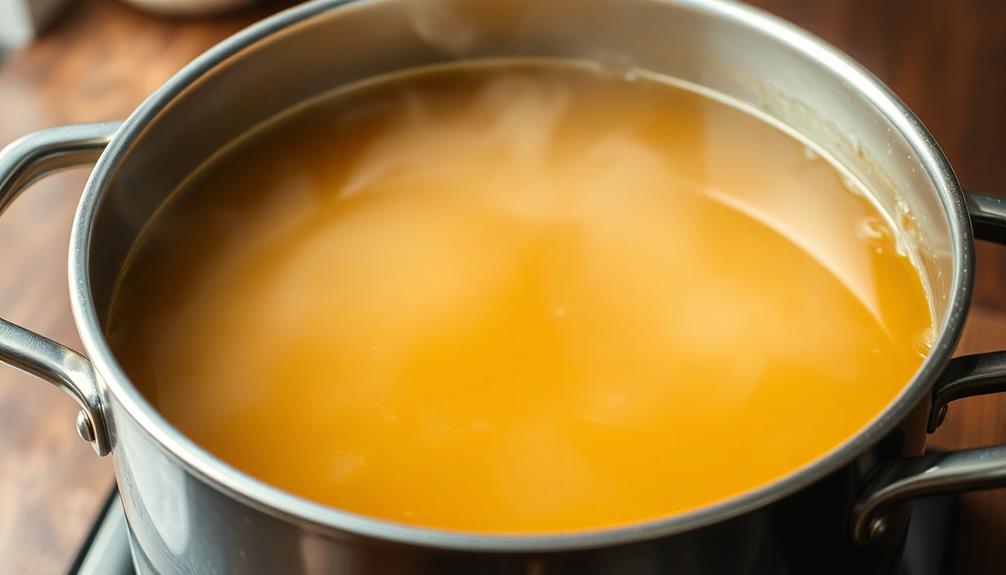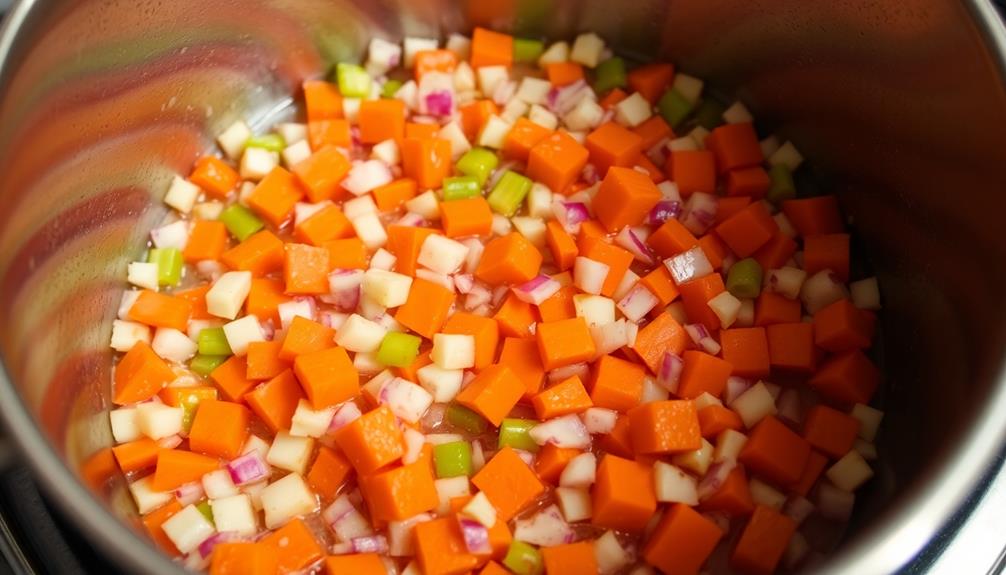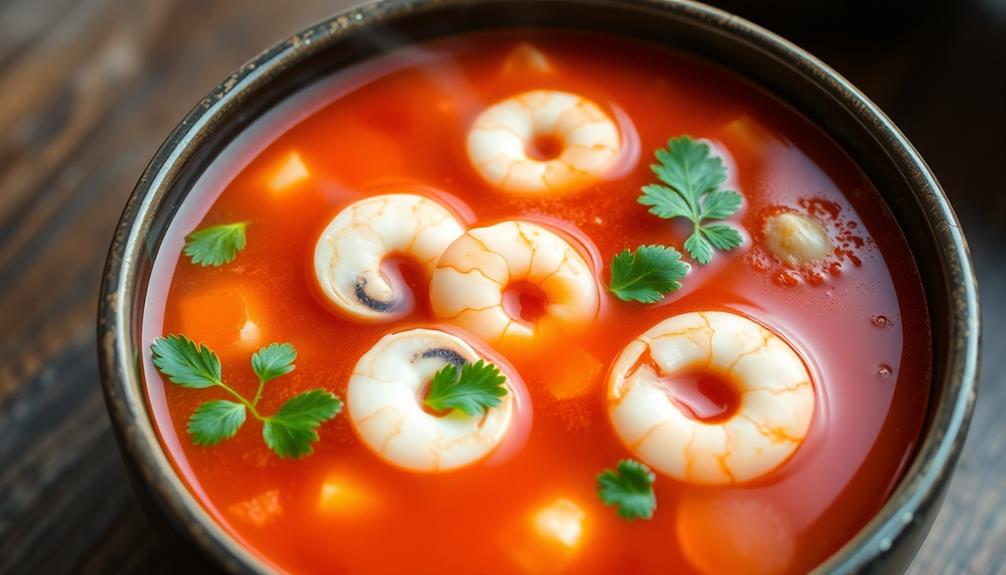Mulligatawny, the captivating Anglo-Indian soup, blends a vibrant fusion of spices, vegetables, and protein, delighting taste buds with its comforting warmth and distinct flavors. Tracing its roots to colonial India, this beloved dish combines the essence of Tamil cuisine with British culinary influences, resulting in a hearty and aromatic creation. Featuring a creamy coconut broth, aromatic curry powder, and a variety of fresh ingredients, mulligatawny offers a harmonious balance of spice, creaminess, and nourishment. Whether you're looking to warm up on a chilly day or explore the rich culinary heritage of India and Britain, this soup promises a truly unique and satisfying experience.
Key Takeaways
- Mulligatawny soup originated in colonial India, a fusion of Indian and British culinary traditions, reflecting the cultural exchange between the two regions.
- The soup's name is an Anglicized version of the Tamil words "milagu" (pepper) and "tanni" (water), indicating its spicy pepper-based origins.
- The classic mulligatawny recipe combines aromatic spices, such as curry powder, cumin, and turmeric, with a creamy coconut milk base and a variety of vegetables and proteins.
- Mulligatawny soup offers a hearty and comforting dining experience, with the option to adjust spice levels and experiment with different protein sources.
- The dish's cultural significance lies in its ability to showcase the adaptability of traditional recipes and the blending of diverse culinary influences.
History
The origins of mulligatawny soup can be traced back to the colonial era in India. During this time, British officers and administrators were introduced to the flavors of South Indian cuisine. They were particularly intrigued by a spicy pepper-based soup known as "milagu-tannir," which translates to "pepper water" in Tamil.
As the British settlers adapted to life in India, they began experimenting with local ingredients and techniques. They added herbs, vegetables, and even meat to create a heartier, more substantial dish. The name "mulligatawny" is believed to be an Anglicized version of the original Tamil term.
Over time, the recipe evolved, blending Indian and British culinary traditions. Today, mulligatawny soup is enjoyed around the world as a flavorful fusion of cultures. Its unique blend of spices, including curry powder, turmeric, and cumin, creates a comforting and aromatic dish that warms the soul.
Recipe
Mulligatawny soup is a fragrant and flavorful dish that originated in India. This creamy soup combines a blend of spices, vegetables, and protein to create a satisfying and comforting meal. The name "mulligatawny" is derived from the Tamil words "milagu" meaning pepper and "tanni" meaning water, reflecting the soup's peppery and aromatic character.
This recipe offers a classic preparation of mulligatawny soup, ensuring a delightful and authentic experience. Whether you're looking to warm up on a chilly day or explore the depths of Indian cuisine, this dish is sure to delight your taste buds.
- 1 pound boneless, skinless chicken thighs, diced
- 2 tablespoons olive oil
- 1 onion, diced
- 2 carrots, peeled and diced
- 2 celery stalks, diced
- 3 cloves garlic, minced
- 1 tablespoon curry powder
- 1 teaspoon ground cumin
- 1 teaspoon ground coriander
- 1/2 teaspoon turmeric
- 1/4 teaspoon cayenne pepper
- 4 cups chicken broth
- 1 (13.5 ounce) can coconut milk
- 1 apple, peeled, cored, and diced
- 1/2 cup yellow split peas
- Salt and black pepper to taste
- Chopped cilantro for garnish
In a large pot or Dutch oven, heat the olive oil over medium-high heat. Add the diced chicken and cook until browned on all sides, about 5-7 minutes. Remove the chicken from the pot and set aside.
In the same pot, sauté the onion, carrots, and celery until softened, about 5 minutes. Add the garlic and cook for an additional minute, until fragrant. Stir in the curry powder, cumin, coriander, turmeric, and cayenne.
Pour in the chicken broth and coconut milk, then add the diced apple and split peas. Bring the mixture to a boil, then reduce the heat and let it simmer for 30 minutes, or until the split peas are tender.
Return the cooked chicken to the pot and season with salt and pepper to taste. Serve the mulligatawny soup hot, garnished with chopped cilantro.
For best results, be sure to use a high-quality curry powder and adjust the amount of cayenne pepper to suit your desired level of spiciness. You can also experiment with different types of protein, such as shrimp or lentils, to create your own unique twist on this classic dish.
Cooking Steps
First, you'll sauté the onions and other aromatic veggies until they're nice and soft.
Then, you'll stir in the fragrant curry powder.
Next, you'll pour in the chicken stock and let the flavors meld.
After that, you'll add the remaining vegetables and let everything simmer until tender.
Step 1. Sauté Onions and Aromatics

Next, sauté the onions and aromatics to build the foundation of this Mulligatawny soup. Grab a large pot and heat a couple of tablespoons of oil over medium heat.
Once the oil is shimmering, add the finely chopped onions. Cook the onions, stirring occasionally, until they're nice and soft, about 5 to 7 minutes.
Now, it's time to add the aromatic spices. Toss in the minced garlic, grated ginger, and curry powder. Stir everything together and let the flavors meld for about 2 minutes.
The aroma will fill your kitchen and get your taste buds tingling!
Adding these aromatic ingredients at the beginning is key to creating a flavorful base for your Mulligatawny. The onions, garlic, and ginger will provide a savory foundation, while the warm curry powder will lend its signature spice.
Get ready for your house to smell amazing!
Step 2. Add Curry Powder

Now that the onions are softening, it's time to add the curry powder. This blend of aromatic spices will bring a bold, earthy flavor to your Mulligatawny soup.
Start by adding a couple of teaspoons of your favorite curry powder to the pot. Stir it in well, making sure it coats all the onions. You'll immediately start to smell the fragrant spices – it's mouth-watering!
The curry powder contains a mix of spices like turmeric, cumin, coriander, and chili peppers, which not only enhances the flavor but may also offer health benefits due to their antioxidant properties. This gives the soup a slightly spicy kick that's so delicious.
Let the curry powder cook for a minute or two, allowing the flavors to bloom and meld with the onions. This is an important step, as it ensures the curry powder's full flavor comes through in every bite.
Get ready for your kitchen to be filled with the most incredible aroma – it's going to make your tastebuds tingle in anticipation!
Step 3. Add Chicken Stock

After allowing the curry powder to bloom, it's time to add the chicken stock. This is a crucial step that brings all the flavors together, creating the signature taste of mulligatawny soup.
Go ahead and pour in the chicken stock, making sure to use a high-quality brand for the best results. As the stock hits the pan, you'll notice the aroma start to build, filling your kitchen with the warm, comforting scents of this beloved dish.
Gently stir the mixture, allowing the stock to fully incorporate with the curry powder and other ingredients. The chicken stock acts as the base, providing a rich, savory foundation for the soup.
It helps to thin out the consistency, creating a smooth, velvety texture. As it simmers, the flavors will continue to meld together, becoming even more harmonious and delightful.
Get ready for your kitchen to be filled with the inviting aromas of this classic Anglo-Indian soup.
Step 4. Add Vegetables

With the fragrant chicken stock now incorporated, it's time to add the vegetables. First, dice up some onions and carrots. The onions will add a lovely sweetness, while the carrots bring a touch of earthy flavor.
Next, mince a few cloves of garlic. The garlic will infuse the soup with its bold, pungent aroma. Toss the onions, carrots, and garlic into the pot and let them sizzle for a few minutes. This allows the vegetables to soften and their flavors to meld together.
Now, it's time to add the potatoes. Peel and dice them into bite-sized pieces. The potatoes will thicken the soup, making it nice and hearty.
Don't forget the cauliflower florets! They'll lend a lovely creaminess to the broth. Finally, stir in the fresh spinach. It will wilt down, adding a pop of vibrant green color and a subtle, leafy taste.
With all the vegetables incorporated, the soup is really starting to come together now.
Step 5. Add Coconut Milk

To lend the Mulligatawny soup a rich and creamy texture, you'll stir in some coconut milk. This'll add a lovely, velvety consistency that'll complement the spices and vegetables perfectly.
The coconut milk also helps to mellow out any lingering heat, creating a nicely balanced flavor profile.
You'll want to pour in the coconut milk towards the end of the cooking process, after the other ingredients have had a chance to meld together. Start with about a cup, then taste and adjust as needed.
The coconut milk shouldn't overpower the other flavors, but rather enhance them. Be sure to whisk it in thoroughly so there are no lumps.
Once the coconut milk is incorporated, let the soup simmer for another 5-10 minutes to allow the flavors to come together. This extra time ensures the coconut milk is fully incorporated and the soup reaches its optimal, creamy consistency.
The end result will be a wonderfully rich and nourishing Mulligatawny soup.
Final Thoughts
Mulligatawny Soup is a delightful dish that combines a harmonious blend of spices, vegetables, and protein. As you've discovered, adding coconut milk at the end gives it a rich, creamy texture that's simply divine.
Now, let's wrap up our journey through this beloved Anglo-Indian soup.
The final thoughts are simple: Mulligatawny is a dish that truly showcases the vibrant flavors of India. Each spoonful is a symphony of aromatic delights, from the warmth of cumin to the gentle heat of chili peppers. For those who prefer a bit of creaminess and richness in their soups, Mulligatawny can also be prepared as a creamy seafood soup. The addition of tender shrimp, flaky fish, and creamy coconut milk adds a new depth of flavor to this already exquisite dish. No matter how it’s prepared, Mulligatawny is sure to be a hit with anyone who loves bold, adventurous flavors.
The vegetables, such as carrots and potatoes, add a satisfying heartiness, while the protein, be it chicken or lentils, provides a filling and nourishing element.
As you savor the last bites, you'll be left with a deep sense of comfort and satisfaction.
Mulligatawny Soup is a testament to the power of cultural exchange, where East and West come together to create a truly exceptional culinary experience.
Enjoy every moment, and don't be afraid to experiment with your own twists on this timeless recipe.
Frequently Asked Questions
How Do You Pronounce "Mulligatawny"?
To pronounce "mulligatawny," say "mul-li-guh-taw-nee." The word has Tamil origins, so it may sound unfamiliar at first, but with a little practice, you'll be able to say it confidently.
Can Mulligatawny Be Made Vegetarian?
Absolutely, you can make mulligatawny vegetarian. The soup's spices and flavorful broth work wonderfully with plant-based proteins and veggies. It's a delicious, customizable dish that can easily accommodate vegetarian and vegan diets.
What Is the Shelf Life of Mulligatawny Soup?
Freshly made mulligatawny soup can typically last 3-4 days in the refrigerator when stored properly in an airtight container. However, its shelf life may vary depending on the ingredients and preparation method used.
Is Mulligatawny Gluten-Free?
Mulligatawny soup can be gluten-free, but it depends on the recipe. Many traditional recipes call for flour or other gluten-containing ingredients, so you'll need to check the specific ingredients or look for a gluten-free version.
What Are Some Common Variations of Mulligatawny?
Some common variations of mulligatawny include chicken, vegetable, or lentil-based broths, and you can find versions with spices like turmeric, cumin, and coriander. You can make it as mild or as spicy as you like.










